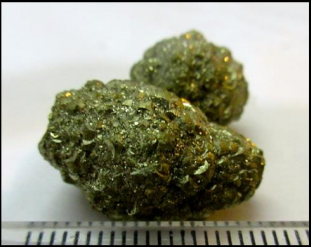Cr (VI) Removal From Tannery Wastewater by Syrian Natural Pyrite as a Reducing Agent
Keywords:
Syrian pyrite, Cr(VI) removal, tannery wastewaterAbstract
In this study, the Syrian natural pyrite from Hosen Suleiman area in Safita/Tartous governorate was used as a reducing agent to remove Hexavalent chromium Cr(VI) from tannery wastewater in aerobic conditions. The result showed that pyrite was a sole phase and mainly composed of Fe (43.2%) and S (40.3%) as well as other impurities (16.5%). The analysis of tannery effluent revealed high values of TDS (28.5g/L), COD (3680mg/L), BOD520 (1500mg/L), and Cr(VI) (13.5mg/L). Batch experiments, as a function of contact time, pH, adsorbent dosage, and initial Cr(VI) concentration, were carried out to determine the optimal removal conditions for Cr(VI). The results showed that:(1) contact time was 6 hours to reach a state of equilibrium. (2) The Cr(VI) reduction was found to be pH dependent and occurred under acidic conditions of pH 2.2-2.5. (3) The Cr (VI) reduction rate increased with a decrease in initial Cr (VI) concentration as the rate of Cr(VI) removal was dependent on the initial pyrite concentration. Eventually, these conditions were applied on real tannery wastewater for Cr(VI) removal. The study demonstrated that the percentage of Cr(VI) removal was found to be 77%.
References
Adra Et Al, “Arsenic Scavenging By Aluminum-Substituted Ferrihydrites In A Circumneutral pH River Impacted By Acid Mine Drainage.,” Environ. Sci. Technol, VOL.47, Issue.22, pp.12784–12792,2013.
R. Murphy And D. Strongin, “Surface Reactivity Of Pyrite And Related Sulfides,” Surf. Sci. Rep, VOL.64, Issue.1, pp.1–45,2009.
Kantar, C. Ari, S. Keskin, Z. G. Dogaroglu, A. Karadeniz, And A. Alten, “Cr(VI) Removal From Aqueous Systems Using Pyrite As The Reducing Agent: Batch, Spectroscopic And Column Experiments,” J. Contam. Hydrol, VOL.174, pp.28–38,2015.
Z. Yang Et Al., “Inhibition Of U(Vi) Reduction By Synthetic And Natural Pyrite,” Environ. Sci. Technol, VOL.48, Issue.18, pp.10716–10724,2014.
D. Muthaiah, “Hazardous heavy metal ions in the environment and removal of Hg from industrial effluents using layered double hydroxides as adsorbents,” International Journal of Scientific Research in Chemical Sciences, VOL. 5, Issue.3, pp.1–7, 2018.
W. F. Fuck, M. Gutterres, N. R. Marcílio, And S. Bordingnon, “The Influence Of Chromium Supplied By Tanning And Wet Finishing Processes On The Formation Of Cr(Vi) In Leather,” Braz. J. Chem. Eng, VOL.28, Issue.2, pp.221–228,2011.
Markiewicz, I. Komorowicz, A. Sajnóg, M. Belter, And D. Bara?kiewicz, “Chromium And Its Speciation In Water Samples By HPLC/ICP-MS – Technique Establishing Metrological Traceability: A Review Since 2000,” Talanta, VOL.132, pp.814–828,2015.
E. Barrera-Díaz, V. Lugo-Lugo, And B. Bilyeu, “A Review Of Chemical, Electrochemical And Biological Methods For Aqueous Cr(Vi) Reduction,” J. Hazard. Mater, VOL.223–224, pp.1–12,2012.
B. Dhal, H. N. Thatoi, N. N. Das, And B. D. Pandey, “Chemical And Microbial Remediation Of Hexavalent Chromium From Contaminated Soil And Mining/Metallurgical Solid Waste: A Review,” J. Hazard. Mater, VOL.250–251, pp.272–291,2013.
P. Miretzky And A. F. Cirelli, “Cr(Vi) And Cr(III) Removal From Aqueous Solution By Raw And Modified Lignocellulosic Materials: A Review,” J. Hazard. Mater, VOL.180, Issue.1–3, pp.1–19,2010.
Houda Et Al. "Reduction remediation of hexavalent chromium by pyrite in the aqueous phase." JApSc VOL.7, Issue.11, pp.1522–1527,2007.
US Environmental Protection Agency. " Method 3050B Acid Digestion of Sediments, Sludges, and Soils 1.0 Scope and Application " 1996.?
C. L. Caldeira, V. S. T. Ciminelli, A. Dias, And K. Osseo-Asare, “Pyrite Oxidation In Alkaline Solutions: Nature Of The Product Layer,” Int. J. Miner. Process, VOL.72, Issue.1–4, pp.373–386,2003.
USEPA, March. "Methods for chemical analysis of water and wastes." Environmental Monitoring and Support Laboratory Cincinnati, OH, USA: 1983.
US Environmental Protection Agency. "Method 7196A: Chromium, hexavalent (colorimetric)." 1992.?
M. Descostes, P. Vitorge, And C. Beaucaire, “Pyrite Dissolution In Acidic Media,” Geochim. Cosmochim. Acta, VOL.68, Issue.22, pp.4559–4569, 2004.
Y. Shao-Horn And Q. C. Horn, “Chemical, Structural And Electrochemical Comparison Of Natural And Synthetic Fes2 Pyrite In Lithium Cells,” Electrochimica Acta, VOL.46, Issue.17, pp.2613–2621,2001.
Z. Üstündag?, ?. Üstündag?, And Y. Ka?an Kad?o?lu, “Multi-Element Analysis Of Pyrite Ores Using Polarized Energy-Dispersive X-Ray Fluorescence Spectrometry,” Appl. Radiat. Isot, VOL.65, Issue.7, pp.809–813, 2007.
M. Chowdhury, M. G. Mostafa, T. K. Biswas, A. Mandal, and A. K. Saha, “Characterization of the Effluents from Leather Processing Industries,” Environ. Process, VOL.2, Issue.1, pp. 173–187,2015.
M. Chojnacka And D. Wawrzak, “Kinetics Of Pyrite Oxidation In Acidic Potassium Dichromate Sulutions,” Physicochemical Problems Of Mineral Processing, VOL.41,pp117-124,2007.
Y.-T. Lin And C.-P. Huang, “Reduction Of Chromium(Vi) By Pyrite In Dilute Aqueous Solutions,” Sep. Purif. Technol, VOL. 63, Issue.1, pp.191–199, 2008.
Zouboulis, K. A. Kydros, And K. A. Matis, “Removal Of Hexavalent Chromium Anions From Solutions By Pyrite Fines,” Water Res, VOL. 29, Issue.7, pp.1755–1760,1995.
M. Mullet, F. Demoisson, B. Humbert, L. J. Michot, And D. Vantelon, “Aqueous Cr(Vi) Reduction By Pyrite: Speciation And Characterisation Of The Solid Phases By X-Ray Photoelectron, Raman And X-Ray Absorption Spectroscopies,” Geochim. Cosmochim. Acta, VOL.71, Issue.13, pp.3257–3271,2007.
Kantar, “Role Of Low Molecular Weight Organic Acids On Pyrite Dissolution In Aqueous Systems: Implications For Catalytic Chromium (VI) Treatment,” Water Sci. Technol, VOL.74, Issue.1, pp.99–109,2016.

Downloads
Published
How to Cite
Issue
Section
License

This work is licensed under a Creative Commons Attribution 4.0 International License.
Authors contributing to this journal agree to publish their articles under the Creative Commons Attribution 4.0 International License, allowing third parties to share their work (copy, distribute, transmit) and to adapt it, under the condition that the authors are given credit and that in the event of reuse or distribution, the terms of this license are made clear.





